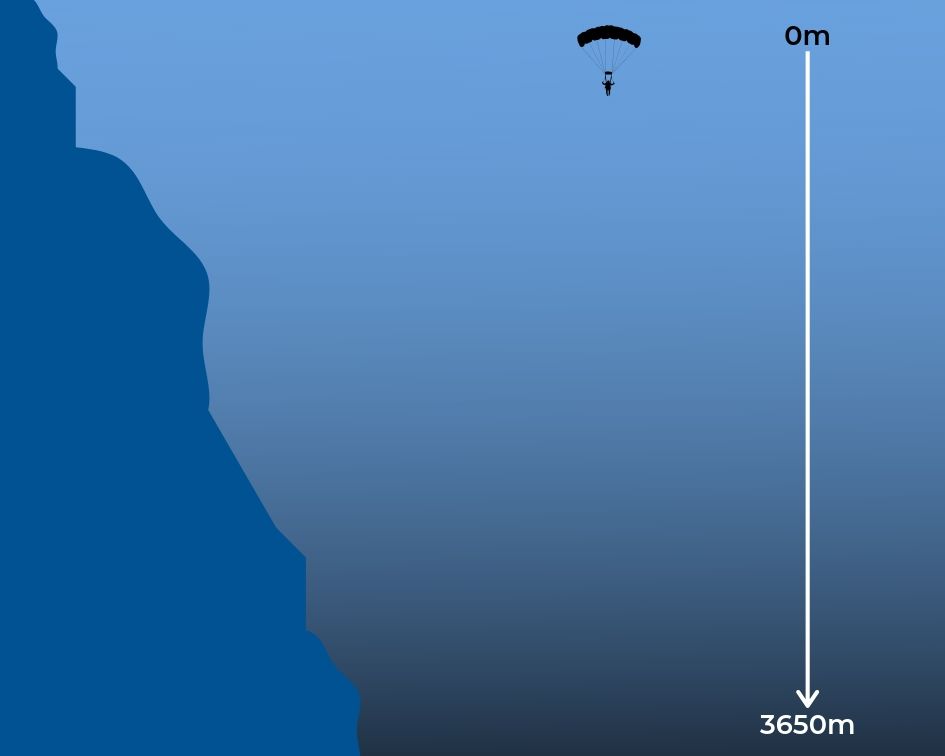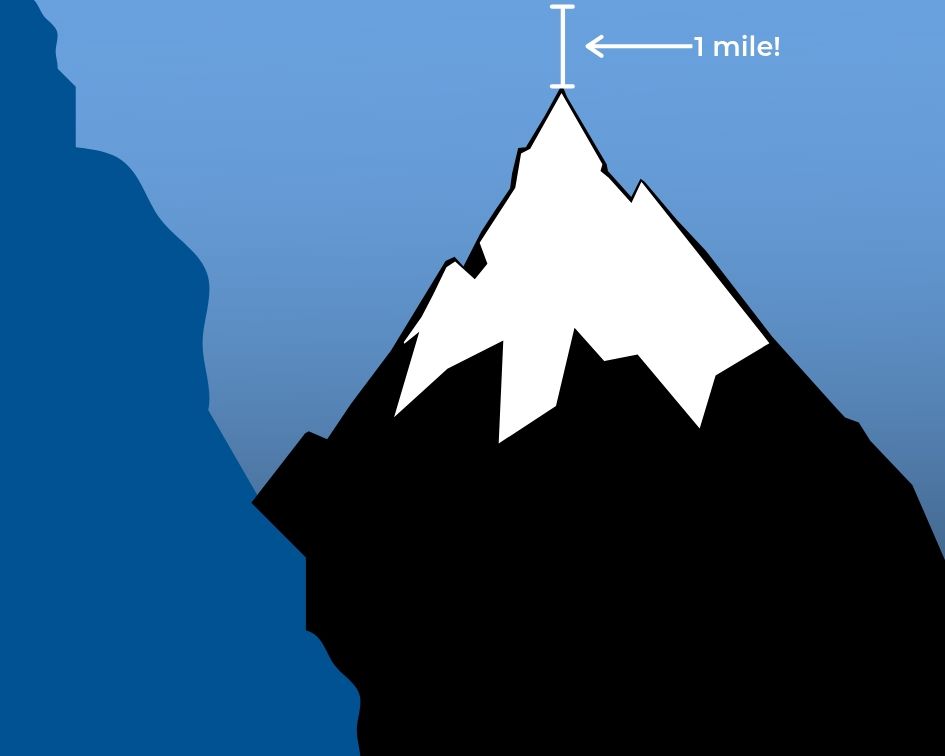Sometimes when you dive, it feels as though you’re in the depths of the oceans. The reality is, we’re barely even dipping our toe in. It’s hard to fathom how deep the oceans actually are – so here we’re going to look at the depths we dive, in perspective.
Bright and Shiny – The Sunlight Zone
The first 200m of the ocean are known as “The Sunlight Zone”. They are pretty light and warm and boast the most life in all the oceans. This is the bit most commonly explored by humans – particularly the first 50m or so.
The odds that you will ever see below this depth as a recreational diver are pretty slim. That being said, the experience even from 10m vs 30m can differ a lot.
The first 10m
Ok, so the first 10 metres under the surface are the most accessible. Pretty obvious really. In the Gilis, with our crystal clear waters, you can see down to 10m from our boats. At some of our dive sites like Hallik and Turtle Heaven, you can spot turtles and even count the fishes from the surface.
Put on a mask and float on the surface and you can see even more. Swimming out from the shore in front of our shop you can spot turtles, eagle rays and more. If you’re a good freediver, you can reach this depth with ease with no special equipment. But remember, no freediving for at least 24 hours after scuba diving!
If you’re looking for a bit of a closer look, our discover scuba diving program will get you down to a maximum depth of 12m. After a short theory session and a few pool skills, you’re ready to see your first glimpse of the world from 10m.
Physically, not a lot changes. The pressure doubles from the surface, from one bar to two. Luckily, our bodies are also made of mostly water. Aside from a few pesky air spaces (which we can equalise) we compensate pretty well and don’t notice the change!

10m – 20m
Now we’re talking. To reach these depths, you need a few more skills. On our SSI Open Water Course, you will learn to dive to a depth of 18m. You’ll also be able to use your qualification to do this all over the world.
What is different now? Well the pressure increases again, to 2 bar. The sunlight starts to change also. Depending on how sunny it is and the visibility of the water, you may notice it becomes a little darker. Because of the density of the water, colours from the red end of the spectrum become less visible and things look less vibrant.
20m – 30m
To progress to 30m below the surface, you’ll need to do an Advanced Adventurer Course or a deep adventure dive. You’ll learn more about how the pressure changes and things are a bit different to shallow dives.
The pressure is now 4 times what it is on the surface. The colour red will be almost non-existent – a red chocolate bar wrapping will look almost black. If you shine a torch on it though, it will appear red again. This is because the light source is closer and the wavelengths aren’t being absorbed by so much water. Magic!
Another thing that starts to happen is that, if you’re scuba diving, nitrogen starts to become toxic. This isn’t bad for your health at all, but it will start to affect your brain. This leads to a sensation called nitrogen narcosis. Some feel intoxicated, some feel slow and some feel nothing at all. The solution for all cases is the same, go up a few metres and you’ll be back to normal.
Let’s get technical
Below 30m, it gets a little more complicated for scuba divers. The time we can stay at this depth without doing decompression stops gets pretty low. By introducing the use of different air mixtures, more tanks and decompression stops, you can get deeper and stay longer than on recreational dive gear. You can learn more about how this works on our Advanced Nitrox and Decompression Procedures course with our lovely Pablo.
The maximum operating depth of this course is 45m. Commercial divers often go much deeper using different air mixes and special equipment like advanced diving bells.

Get a little deeper – The Twilight Zone
From 200m, we enter The Twilight Zone. The light starts to be filtered out completely and the water gets darker and darker the deeper you go. The deepest freedive was to 214m, just in this zone. The deepest scuba dive was t0 332m – he used 9 tanks and decompressed for 14 hours on the way back up!
Some creatures spend their lives down here in the shadowy depths and others are only fleeting visitors. Blue whales dive down to depths of 500m and more to hunt giant squid. The creatures down there start to get a little…weird. Living their lives at almost 100 bar of pressure with little light means they look more like things you’d find in outer space than anything else.
The biggest migration in the world also happens here. Fishermen using sonar once thought it was the seabed changing depth. It was actually a nightly migration of twilight zone animals making their way to shallower waters to hunt, before sinking back down at dawn.
Need some perspective for this one? Well, at roughly 730m submarines reach the “danger zone” meaning that their hulls can’t withstand much more pressure. The tallest building in the world, the Burj Khalifa, would reach 830m.

Ok, shall we stop now? – The Midnight Zone
At 1000m we start to enter The Midnight Zone. From here, no sunlight will penetrate and as such, there is no plant life. All life is now carnivorous, either predatory or a scavenger. The animals now look bizarre, eat rarely and grow very slowly due to the lack of sustenance.
These creatures can also not survive being brought to the surface. The pressure drop interrupts cell communication and causes paralysis. That explains why you’ve never seen any of these weird sea-aliens in aquariums!
Some whales, such as the sperm whale, can dive this deep to find food. They can use echolocation to identify large shoals of giant squid. Despite this, life here is scarce and hard.
It’s getting a little harder to picture this distance – the average height of a skydive is about 3650m. At maximum velocity, it would take a human being 69 seconds to fall this distance.

No really, I’m a little scared – The Abyss
From 4000m, we enter The Abyss. Dun-dun-duuuun. Abyss literally means “bottomless” in Greek. Obviously this isn’t true. But there’s still a long way to go before the deepest point. The waters down here are also completely black. They are a couple of degrees above freezing as well and this rarely changes.
The oxygen levels are basically nil due to the lack of plants. There is also have a higher density of minerals like phosphorus, silicon and nitrogen due to the dead matter that floats down from above. These conditions make it toxic for any animals that don’t live down there.
Have you ever climbed a mountain? Like a big mountain? How about Kilimanjaro? If you submerged Kilimanjaro at the bottom of the Abyss level of the ocean, there would still be 100m or so more ocean on top!
It even goes that deep?! – The Trenches
The deepest level, the trenches. The most famous of the trenches – the Mariana Trench, is also the deepest. The lowest point is called Challenger Deep after the HMS Challenger which discovered it in the 1870s. It has a maximum depth of 10,928m. If Mount Everest were submerged at the bottom, there would be more than 2km of water above it before it reached the surface.

Almost nothing survives down here. On manned trips in submersibles, no creatures longer than an inch have been observed and no fish at all. The pressure is 1,086 bar.
So, why do we do it?
So, after that mildly terrifying journey into ocean perspective – why do we dive it? Well, there are lots of different arguments for that. Some say they like the feeling of being tiny. Some like the feeling of exploration – after all, we’ve only explored 5% of the oceans. And when you’re engrossed on a Gili coral reef – it’s hard to believe that the ocean is anything other than light and beautiful! Whatever the reasons, we know we love it. Come and explore the oceans with us now!

By Rachel Thannhauser
